- What is the importance of Varanasi/Kashi? Which are the Chhoti Kashi’s across India and why did they come up? Kasghar in Xinjiang was known as Kashi earlier.
Recently, in a political slugfest, some Congress leaders started to poke fun of the city of Mandi, asking about the ‘bhaav’ of a certain contestant from the Lok Sabha constituency. The contestant in turn hit back, telling them about the status of Mandi as “Chhoti Kashi”, which sparked a lot of interest among ordinary people. A piece by veteran journalist S Shukla referred to the many Kashis across India. Mr.
Shukla called it
a result of the multiple Shiva temples, and becoming a centre of knowledge,
dharma and darsana of which Kashi or
Varanasi was the original.
A contrasting
view has been taken by Indologists over the years. A 2022 piece in the Indian Express quoted several such scholars in discussing the importance and allure of Kashi. Diana Eck noted in his 1993 book on Kashi that “although
Shiva is omnipresent, there are a few places that are especially transparent to
his luminous presence. And of these few, the city of light is the most
brilliant of all.”
Scholars
like Indira Vishwanathan Peterson when asked about the various Kashis across India dismiss the phenomenon as a result of ‘Brahminical ideology’ moving across India. In the same interview, Ms. Peterson states: “Each of these sites have local mythologies attached to them. By having a Kashi Vishwanatha Temple there or calling it Kashi, the attempt was also to localise the experience of Kashi so that the poorest of the poor make the pilgrimage.”
Albums Ghats of Kashi+Wall-Paintings
of Kashi+Kashi on Kartik
Purnima+Ganga Yatra from Kashi to Bay of Bengal
Then there were
others like Wendy
Doniger that talk about replication of Kashi as a means to “encourage people to pay the local priests for religious rituals instead of taking the trouble to have them performed far away in Kashi.”
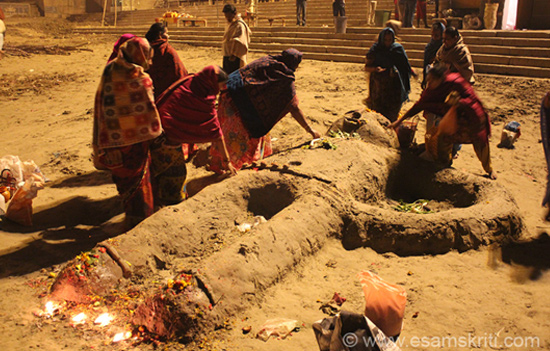 Devotees offering respects to Bhishma Pithama, Assi Ghat, Kashi. 2013.
Devotees offering respects to Bhishma Pithama, Assi Ghat, Kashi. 2013.
Swami
Varishthananda wrote in the Prabuddha
Bharata, magazine of the Ramakrishna Order. Excerpts, “Varanasi is famous for three things - learning, burning, and turning. This is the story of Kashi, the city of light and liberation, which name is derived from the same
Sanskrit root as prakasa, which means- kasayati
prakasayati iti kasi. The atmosphere of holy spirituality is undoubtedly
densest within the precincts of the shrine of Vishwanatha especially in the
sanctum sanctorum, yet the whole atmosphere of Varanasi is spiritually
surcharged and is especially conductive to religious and scholastic pursuits
and spiritual growth. Not only the gods, but all the Tirthas too reside in
Varanasi. One of the most famous of these tirthas is Kedareshwara. Situated on the banks of the Ganga, a steep flight of
steps leads up to this temple with red and white vertical stripes painted on
its outer walls in the fashion of South Indian temples. This linga of Shiva is svayambhu, self-manifest.”
“The Annapurna and Kashi Vishwanath Temples symbolize the essence of Indian culture, eloquently articulated in this well-known couplet: Mata me parvati devi pita devo mahesvara; Bandhavah
siva-bhaktasca svadeso bhuvana-trayam. Translated
as, My mother is Devi Parvati; my father Lord Maheshwara, my relatives are Shiva’s devotees, and my home all the three worlds. Varanasi has the unique distinction of having separate temples dedicated to all the nine forms of Mother Durga.”
“Many great saints and sages made Banaras either their home or workplace e.g. Veda Vyasa, Sankaracharya and in modern times Swami Vishwarupanda composed his Bengali magnum opus Vedanta Darshan here.” Learned and spiritually evolved like Sant Kabir, Guru Ravidas and Sant
Tulsidas and in modern times Trsilanga Swami, Swami Bhakarananda Saraswati lived
here.
Varanasi’s literary tradition includes Munshi Premchand and Bhartendu Harishchandra. Many reputed gharanas or schools of music developed
in Banaras over the last few centuries.
Swami Vivekananda once said, “Art, science, and religion are but three different ways of expressing a single truth. The saints, sages, and savants of Varanasi verily express that single truth in their own inimitable style. The resultant melody is vibrant Varanasi, the city of Shiva.”
Read Why is Varanasi a leading pilgrimage destination
Of course, it is convenient that many of these explanations tend to skip the discussion’s pivot, the Puranas, from which many of the current tirtha
kshetras derive their authority and sanctity.
To simply claim
that the presence of Kashi Vishwanatha or any Shiva temple and some Sanskrit
gurukuls as the sole hallmark of Kashi is injustice to both Kashi and the idea
of what constituted a tirtha. The Skanda Mahapurana has an entire Tirtha Khanda
that precedes the Kashi Khanda. Now, as per Kuber
Nath Sukul,
Kashi Khanda gained authority by the 14th century AD. One of the implications
would be that the significance of Kashi arose only by that time; but that is
certainly not the case.
It
is often forgotten that Kashi was the epicentre of Shaiva, Vaishnava, Buddhist
and Jaina traditions equally.
In the Jaina
tradition, four of the twenty four Tirthankaras - Suparshvanatha (seventh
Tirthankara), Chandraprabhu (eighth), Shreyansanatha (eleventh) and
Parshvanatha (twenty third Tirthankara) were
born in Kashi.
Kashi was just as important a tirtha kshetra for Jainas - so much so that in
the south, Mudabidri near Mangaluru in Karnataka used to be called the Jaina Kashi.
Of course, Kashi
for the Buddhists has a high significance - it was near Saranganatha (saranga
refers to deer) or Sarnath is where Buddha gave his first sermon. Swamiji also wrote, “Sarnath is also home to the Mahabodhi Society, which was started by Angarika Dharmapala on his return from the world Parliament of Religions where he had been one of Swami Vivekananda’s co-delegates.”
Interestingly, Kashgar in Xinjiang, which was a major Buddhist centre, was also called Kashi-giri. As academic “Subhash Kak pointed out in a blog post: “Many Khotanese
cities had Sanskrit names. For example, Khotan in Sanskrit was Gaustana गौस्तन (or Gosthāna गोस्थान) and the modern city of Kashi (Kashgar)
was called Śrīkrīrāti (in Sanskrit Śrī+krī+rāti, श्रीक्रीराति, ‘Glorious Hospitality’). Kashgar itself appears to be the popular name from Sanskrit Kāśa+giri (काशगिरि, bright mountain).”
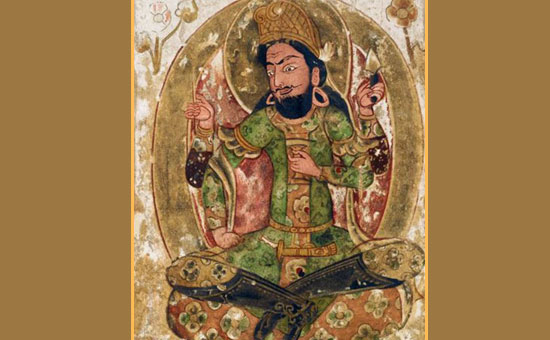 Siva Mahadeva in Khotan.
Siva Mahadeva in Khotan.
Prof. Dr. Shashibala Dean, Centre of Indology, Bharatiya Vidya
Bhavan, wrote
in Sanskrit on the Silk Route, “Hsuan-tsang passed through Kashgar (which he refers to as Ka-sha) in 644 on his return journey from India to China.”
This takes us to something important, meaning of Kashi or “City of Light.” Its name is derived from the same Sanskrit root as prakasa, which means - kasayati prakasayati iti kasi .Light is meant to mean Inner Light not electricity.
In that sense, many of the major pilgrim centre’s that have been listed in the Tirtha Khanda of Skanda Mahapurana and also other Puranas would definitely have classified themselves as a claimant of the title.
However, it is
not just about the title of the city - it is important to note why many of these places are listed as Chhota Kashi.
Where Shiva
resides as per the Puranas, there will be Kashi, and not every such residence
is necessarily linked to the Jyotirlinga darshan. This implies that a river
being adjacent to it need not always be the case either, though you see it
across several prominent Chhoti Kashis such as Mandi (Beas), Purmandal (Devika),
Jaunpur (Gomti), and Tenkasi (Chittar).
The pramaana of
tirthas listed as Chhoti Kashi in almost all cases can be seen in the Tirtha
Khanda and other Puranas. Details on some of these places (11) are-
1. Purmandal, Jammu & Kashmir
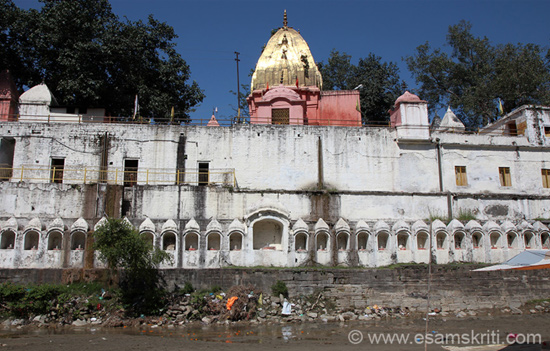
Purmandal is a Pauranic
tirtha kshetra that has great significance. In many scriptures the Devika river
is held sacred even more than the river Ganga. For instance, in the Padma Purana, Sri Krishna
has stated that when Ganga becomes too heavy with the sins of the sinning
bathers in it, she herself bathes in the Devika to get rid of these sins. In
addition to the above, this river has also been referred to in Brahmanda purana, Vayu purana, Narada purana, Visnu purana, Skanda purana, Padma purana, Brihadaranyakopanisad’ and Kathopanised.
The descent of Devika in itself is interesting. Kashyap Rishi after consummation of his dozen year penance prayed before Lord Shiva to bless the Jammu region with a river as holy as Ganga. However, this put Lord Shiva in a dilemma as there was no other river of Ganga’s exalted stature. To solve this dilemma, Mata Parvati decided to herself come down from her abode and flow in the form of Devika. As the river began to flow, Lord Shiva and Kashyap Rishi followed its path. The river originates at Sudh Mahadev, another famous ‘Tirath’ in Jammu, where Lord Shiva slayed Sudhi demon.
Purmandal temple
complex consists of Umapati Shiv Mandir with twin gold plated domes besides 108
other small temples with bunch of Shiv lingams installed in each Mandir. The original
structure was constructed by Raja Veni Datt of Kashmir some 1400 years ago.
In 1838 AD, the
ruler of Punjab Maharaja Ranjit Singh paid his
obeisance at the temple and offered pitchers made of pure gold. Both
Maharaja Ranjit Singh and Dogra Maharaja Gulab Singh are credited with
rebuilding the Umapati Shiv Mandir. Maharaja Gulab Singh constructed 108 Shiv
temples in the Mandir precincts.
2.
Mandi/Rewalsar, Himachal Pradesh
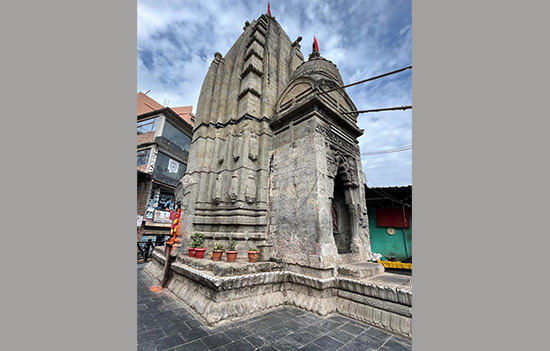 Baba Maha Mrityunjay temple is said to
be the only one in Northern India. The Lord is in a sitting position with his
third eye open. This form of Shiva is known to be a saviour and gives long life
to his devotees.
Baba Maha Mrityunjay temple is said to
be the only one in Northern India. The Lord is in a sitting position with his
third eye open. This form of Shiva is known to be a saviour and gives long life
to his devotees.
Mandi also
carries the epithet of Chhoti Kashi. Situated on the banks of Beas (Vipasha of
the Vedas), the oldest reference for the region is traced back to the Skanda
Purana for the site Rewalsar.
 Rewalsar has a Shiv Mandir, Gurudwara and a temple dedicated to Rishi Lomash.
Rewalsar has a Shiv Mandir, Gurudwara and a temple dedicated to Rishi Lomash.
Interestingly,
this site is sacred to Tibetan Buddhists as well as a moksha dham. As per the
Skanda Purana, Lomash Rishi was trying to find a place to worship and while
travelling, he climbed the top of Drona mountain. From there, he saw a
picturesque lake and decided to meditate. He was later blessed by Lord Shiva and
Goddess Parvati. The old name for Rewalsar
was Hridayalesh,
or King of Lakes, and it is known as the place where Brahma, Vishnu, Ganapati,
Surya and Shiva-Parvata reside together.
Interestingly,
Mandi is the only place where one sees the practice of Trika Shaivism of
Kashmir, evidenced by the Swachhanda
Bhairava presence in Panchavaktra and Trilokinath temples of
Mandi.
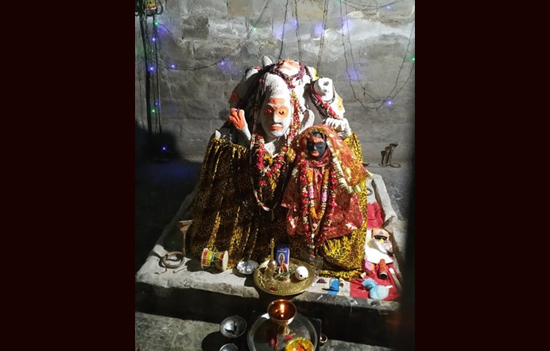 Panchavaktra
Temple - Shiva/Swachhanda Bhairava.
Panchavaktra
Temple - Shiva/Swachhanda Bhairava.
Pic is courtesy Ashok Singhal Further, the city is today famous for its
Shivaratri festival, which witnesses various deities of the Mandi valley
descending down to the city and congregating.
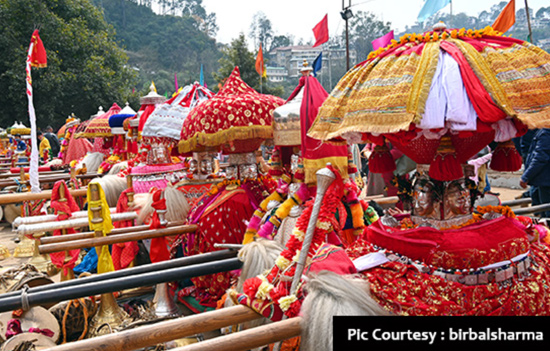 Raths (Palanquin) of Devi Devtas in Paddal ground, Mandi, International Mahashivratri 2022.
Raths (Palanquin) of Devi Devtas in Paddal ground, Mandi, International Mahashivratri 2022.
Read Trilokinath
Temple, Mandi
3.
Uttarkashi, Uttarakhand
Uttarkashi finds
its reference in Kedar Khand of the Skanda Purana, and has uncanny similarities
with the Kashi of the plains as well. With almost as high a veneration as Kashi
of the plain (Varanasi), both the Kashis are situated on the banks of the river
Ganga (Bhagirathi). The area which is held sacred and known as Uttarkashi, lies
between the rivers Syalam and Gad also known as the Varuna and Kaligad known
today as the Asi. The Varuna and the Asi are also the names of the rivers
between which the Kashi of the plain lies. One of the holiest Ghats in
Uttarkashi is Manikarnika so is the one by the same name in Varanasi. Both have
temples dedicated to Vishwanath.
From where the Yamunotri
descends, Uttarkashi finds reference in the Skanda Purana as a place that will
grant mukti. As the shloka goes-
This Uttarkashi is one which gives
salvation to living beings. Blessed are those who are fortunate to live here
during the dark age of Kaliyuga, In this place where all Gods reside.।।7।।
As per the Skanda Purana, Uttarkashi is
the Kashi of the Kaliyuga, and the presence of Lord Parashuram built Kashi
Vishwanatha, Annapurna and Bhairava temples in the city, increases the mirror
imaging of the Kashi of the plains.
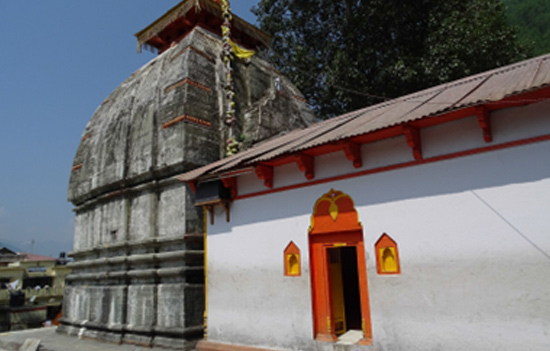 Kashi Vishwanath Temple, Uttarkashi
Kashi Vishwanath Temple, Uttarkashi
Credits
4. Hoshiarpur, Punjab
It is very interesting that the Hindu
traditions and memories of Punjab have literally disappeared. As the home of
Maharshi Bhrigu, the city of Hoshiarpur was definitely a sacred place. In the
olden times, there is this verbal anecdote of the city being referred to as
Chhoti Kashi due to the huge number of temples present there. Local legends
associate several places in the district with the Pandavas. As the Census from 1961 for the district mentions:
Eight
miles north of Hajipur, which contains a well and a temple derives its name
from them. Dasuya is mentioned in the Mahabharata as the seat of Raja Virata in
whose services the Pandavas remained for thirteen years during their exile and
even today, it is called Virat Ki Nagri.
Today, there is a small inkling of this
memory in the form of Mini Kashi. The Panch Shivala temple complex in Hoshiarpur is even today remembered as
that, as this nine hundred year old complex is believed to be a replica of
Varanasi and its five Shivalayas. Interestingly, the Shivlings are also in the
same direction as Kashi.
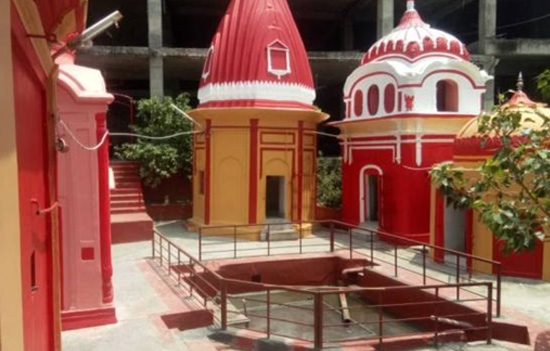 Panch Shivala, Hoshiarpur
Panch Shivala, Hoshiarpur
Credits
Jagran.com and here
What is interesting to note is that
Hoshiarpur is part of Trigarta or Jalandhar, which has significant importance
for both Vaishnavas and Shaktas. Jalandhara hosts the Tripuramalini Shakti
peetha and Tulsi Devi temple, and the place finds reference in the Vishnu
Purana among others.
5. Bhiwani, Haryana
Bhiwani surprises many when one points to
its other name of Chhoti Kashi. With over 300 temples in the city, it remains a
major centre of faith for Hindus. Nearby villages like Mithatal have seen
discoveries of Saraswati Sindhu Civilisation sites in
1968, which is not surprising
as it is part of the larger Saraswati basin. This also serves as a strong
reminder of the cultural continuity of civilisation in India.
6. Jaunpur, Uttar Pradesh (69 kms from Kashi)
On the banks of the Gomti river lies
Jaunpur, which is also known as
Chhota Kashi. The city has innumerable temples that trace historicity back to
at least a thousand years. Many of these temples started to gain importance
only during the past four-five hundred years. The commonalities in the ghats,
the flowing rivers and hundreds of Shiva temples revered across the region,
even in Kashi and Prayagraj, signify the importance beyond the district as
well.
There is interestingly a Panch Shivalaya temple in Jaunpur as well, which is reminiscent of the Hoshiarpur Panch Shivala.
To
see video of temples 5.4 minutes
7. Gola Gokarna Nath, Pilibhit Uttar
Pradesh
This place in Lakhimpur Khiri district is
also known as Chhota Kashi. A corridor is being built for this on the lines of
the Kashi Vishwanath Corridor by the Uttar Pradesh government.
As
per the Varaha Purana, Lord Shiva transformed
himself into a three-horned deer and came down on earth. To search for Him, the
Devas led by Vishnu and Brahma searched and got hold of him. On spotting him,
Brahma and Indra got hold of one horn each, on which Shiva disappeared, leaving
behind the horns. The three horns turned into Shivalinga each, with one of them
being Gokarna Nath. Later, Ravana tried taking this linga back with him to
Lanka, but failed.
The mahatmya of this tirtha is also
mentioned in Shiva Purana, Vaman Purana, Kurma Purana, Padma Purana and Skanda
Purana as well.
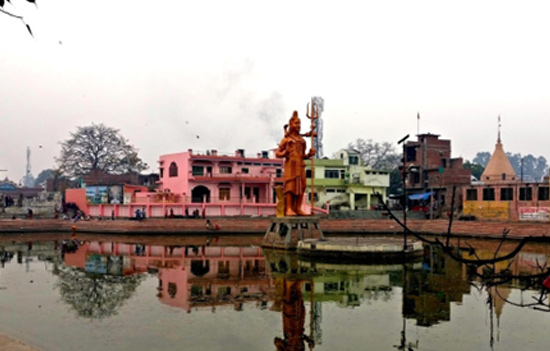
Credits
8. Bikaner Rajasthan
Bikaner has temples at every corner, and
is considered by many to be the grandest city of Rajasthan. It is believed that
there are hundreds of temples in every corner of the city. This includes the
famous Karni Mata Mandir and Kolayat ji in the vicinity, where lies the Kapil Sarovar of Kapil Muni. Set up by Rao Bika, it is interesting to note that the legend of the city’s establishment has a relation with Bhairava.
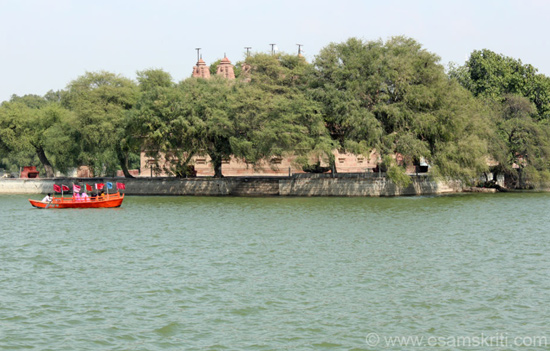
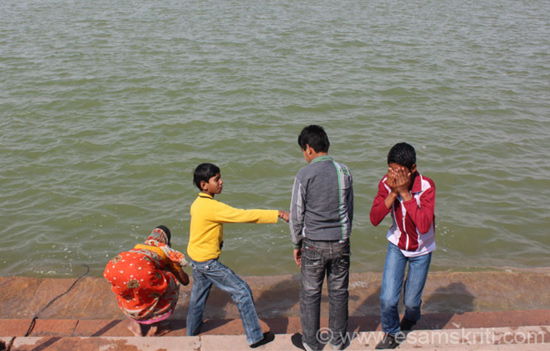 Kapil Sarovar.
Kapil Sarovar.
The Kodamdesar Bhairav Temple is unique
as the Bhairava Temple there originally hails from Jodhpur’s Mandor, and was the second Bhairava temple to be setup after Kashi. The two
sevayats, Suroji and Dedoji Mali, were ordered by Bhairava to move towards
Jangal Desh, which
eventually saw Rao Bika come and set up Bikaner. The condition was simple -
keep walking and never turn back, else I will seat myself. At one place, the
two decided to have a peek, and that was the place where the Kodamdesar
Bhairava, the guardian of Bikaner, today sits.
The parallel of a Bhairava protecting a city has much resonance with Kaal Bhairava, Kashi’s kotwal, and interestingly, the temple does not have a roof to this day.
Similar things are said about the temple
complex of Jaipur as well, given the cluster of temples.
9. Nanjangadu, Karnataka
Nanjanagadu in Karnataka, which houses
the famous Srikanteswara temple, is also referred to as Dakshina Kashi, or
Kashi of the South.
Multiple stories connect the city to the
Kashi in Uttar Pradesh, thanks to the presence of Shiva, Vishnu and Parvati.
Nanjungud is mentioned as Sri Garalapuri in the Shiva Purana, and is the spot where Shiva appeared to kill the Asur Keshi, following which Shiva assured his devotees that his Ansh – a part of His divine self would always remain here and bless humanity.
The town, on the banks of the Kabini, is
known for sins being washed away should one take a dip and pray to
Srikanteswara Swamy. Further, Sri Parashurama meditated at this place to rid
off the crime of killing His mother. The place also has a Dakshina Manikarnika
Ghat, as a gem stone fell from the crown of Devi Parvati into the Kabini at the
spot.
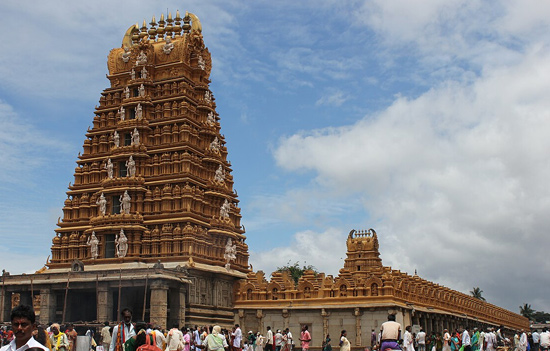
10. Kanchipuram, Tamil Nadu
As one of the Sapta Puris or the seven
cities that grant moksha mentioned in the Garuda Purana, it is no surprise that
Kanchipuram is compared with Kashi. This temple town is broadly divided into
Vishnu Kanchi and Shiva Kanchi where one can find several Vishnu and Shiva
temples respectively.
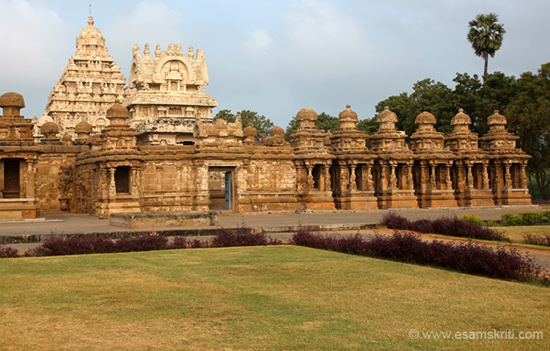 Kailasanatha Mandir, Kanchipuram.
Kailasanatha Mandir, Kanchipuram.
Out of 108 Vaishnava kshetras known as Divya
Desams 14 are located in Kanchi town. The oldest stone inscription in
Kanchi town dates back to the period BC 325-185 when Mourya kings ruled Kanchi.
Rishi Patanjali in his Maha Bhashya (2nd century BC) describes the
Kanchi town as Kanchipurika. The city is the centre of religious education as
much as it is a city of temples and temples galore, which existed even when the
poet Kalidasa lived.
Read About
Architecture and Story of Kailasantha Temple
11. Tenkasi, Tamil Nadu
Tenkasi is an obvious reference to Kashi,
and also houses a Kashi
Vishwanathar temple. The city definitely is a reference to the city of
Kashi in the north.
The Kutraleeshwarar temple (Chitra
Sabha) is one of the five sabhas of Nataraja, an incarnation of Lord Shiva.
Besides this and the Kasi Viswanathar temple, Sankarankoil
temple, Pottalpudur darga, Ilangi Kumarar temple are the other spiritual
places located here.
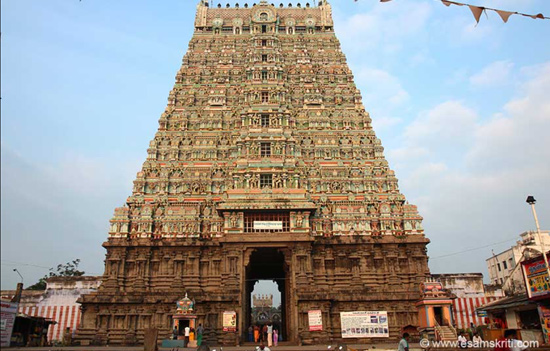
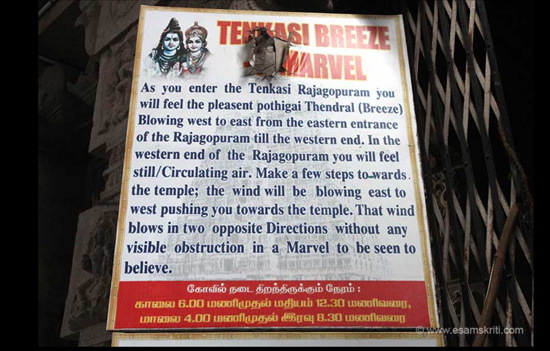
Jatavarman Parakrama Pandiyan who started
his rule from Korkai during 1422 CE was a Shiva Bhakta from the beginning and gave a number
of grants to the Siva temples in that region. During the period he was ruling,
the Kasi Viswanath temple in Varanasi suffered damages due to invasions. Lord
Siva appeared in his dream and asked him to build a temple in the northern
banks of Chitra river, as the Kasi Viswanath temple got destroyed. Accordingly, he started to build the temple
on 6 May 1446.
The story of Tenkasi in particular is very important, because it points to something critical that most western ‘Indologists’ refuse to acknowledge. Many of these Chhoti Kashis were a latter day phenomenon, and while these places were closely linked to important tirthas, the significance arose as
the response to the tragedies that fell upon Kashi due to the Islamic invasions.
KASHI INVASIONS and Impact
As Kuber Nath Sukul also acknowledged, Kashi was under siege since 1024 AD. The first most ‘successful’ attempt that took place was the one led by Qutbuddin Aibak in 1194, where he succeeded and captured Kashi, bringing it under the Delhi Sultanate. Sukul’s words on the attack:
Mohammad Ghori’s army under his Commander-in-Chief Qutbuddin Aibak attacked Varanasi in 1194 and conquered it. The fort was razed to the ground and there was the usual massacre and conversions. In addition to these, a thousand temples were demolished, the town was plundered, and 1400 camel-load of gold and silver and jewels was forwarded to Ghori in Delhi.
This was the first time that Kashi Vishwanath was broken, and the site was used by Aibak’s daughter Razia Sultana to build a mosque on it as part of their iconoclastic movement. To quote Monidipa Bose Dey:
Rebuilding the temple on the same site was not possible because a mosque was constructed there by Razia Sultan of the Delhi-based Mamluk/Slave dynasty during her short reign (1236-40 CE), which is known as Bibi Razia’s mosque and still stands today. Situated on the hilltop (hill of Vishwanath) in central Banaras, on the highest ground, the Bibi Razia’s mosque stands on the exact site where the original 10-11th century-built Vishwanath temple stood before being destroyed in 1194 CE. Bibi Razia’s mosque, built using the destroyed temple parts, is an act of dominance that effectively announced the Islamisation of a site held especially sacred by the Hindus. Around 1230 CE, the Vishwanath temple was re-built within the compound of the ancient Avimukteshvara temple which was first partially destroyed by Mahmud Hussain Shah Sharqi (king of Jaunpur, 1447-1458), and then completely by Sikandar Lodi in 1490. In 1585, Narayana Bhatta, along with Raja Todar Mall, rebuilt the Vishwanath temple. Less than a century later, Aurangzeb destroyed the temple.”
During the Tughlaq and Sharqi rules over
Varanasi, there was barely any respite. But by the time of the Lodis in the
fifteenth century, there was absolutely no respite. Sikander Lodi in 1496 ordered all temples
of Varanasi to be destroyed, and such was the impact that for eighty nine years
there was no temple.
In this brief historicity of the
destruction of temples, an overlap of the some level of standardisation of the
Skanda Mahapurana also takes place. During the overlap of the Tughlaq and
Sharqi rules, it is believed that Kashi Khand became main stream, and so it
would be safe to postulate that the Tirtha Khanda of this Purana and
information on the Tirthas across other Puranas also started to evolve to decentralise Shaiva worship from Kashi.
With this in mind, temples started to come up at other places, or rulers started to replicate the essence of Kashi in whatever capacity they could, to recreate the basic essence of Kashi - the presence of Vishnu, Shiva, Devi and Bhairava as the guardian of this Kashi. Many of the new Kashis that emerged fulfilled an important function - passing on the knowledge of Dharma and Sanskrit to the new generations across regions, thus securing the traditions and knowledge that made Santana Dharma different from others. Another hint on who the teachers and operators of these gurukuls were comes, again, from Sankul’s text:
…the five hundred years between 1194 and 1708 A. D. were very difficult years for the Hindus everywhere esp. in Varanasi. The Vedic learning in Varanasi declined and in the earlier centuries of this period learned men fled from Varanasi to the South or took refuge in remote villages, and the music of Vedic recitation was almost silent in this centre of Vedic learning.
Thus, it may have very well been the case
that many of these chhota Kashis had a more direct connection with Kashi, thus
preserving and even diffusing traditions of erstwhile Kashi.
Not accounting for this shows the nature
of chicanery displayed by Indologists and Marxist-liberal historians both in
India and outside, who instead keep harping Brahminical influence on the rise
of the idea of Kashi.
Kashi does not need ‘Brahminical’ thought to rise; it is an idea seeped in eternity much like Shiva himself.
To read all
articles by author
Also
read
1. Cultural
contributions of the Marathas to the town of Kashi
2. Annapurna
is the Goddess of Kashi
3. Why
does everyone love Kashi
4. Dev
Deepavali Kashi album